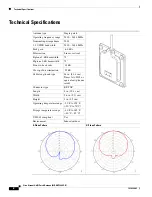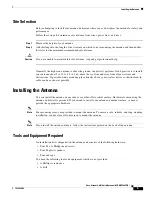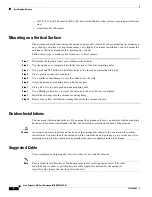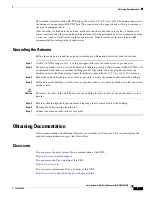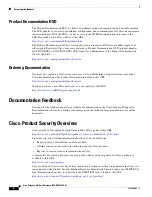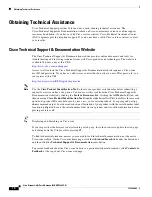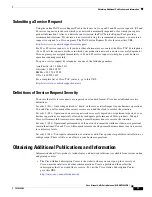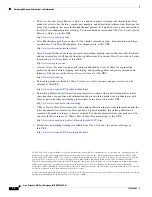
6
Cisco Aironet 6-dBi Patch Antenna (AIR-ANT2460P-R)
78-16940-02
Installing the Antenna
•
A #29 ((0.136-in (3.45 mm)) drill bit (For drywall installation, other surfaces may require a different
size)
•
A small mallet or hammer
Mounting on a Vertical Surface
This procedure describes mounting the antenna on a drywall surface. If you are mounting the antenna on
any other type of surface, your procedure may vary slightly. For indoor installations, you can mount the
antenna so that the antenna cable is pointing up or down.
Follow these steps to mount your antenna on a vertical surface.
Step 1
Determine the location where you will mount the antenna.
Step 2
Use the antenna as a template to mark the locations of the four mounting holes.
Step 3
Use a drill and #29 drill bit to drill four holes at the locations you marked in Step 2.
Step 4
Start a plastic anchor into each hole.
Step 5
Use a mallet or small hamer to seat the anchors into the wall.
Step 6
Align the antenna’s mounting holes with the anchors.
Step 7
Start a #8 x ¾ screw into each antenna mounting hole.
Step 8
Use a Phillips screwdriver to secure the antenna to the wall. Do not overtighten.
Step 9
Install the end caps into the antenna mounting holes.
Step 10
Remove the yellow installation warning label from the antenna radome.
Outdoor Installations
You can mount this antenna outdoors. If you mount the antenna outdoors, you must provide the mounting
hardware. For outdoor installations, Follow the instructions printed on the back of the antenna.
Caution
An orientation arrow is printed on the back of the antenna that indicates the orientation for outdoor
installations. You must install the antenna with the orientation arrow pointing up to prevent any water
intrusion and to provide a drain for any moisture that may accumulate inside the antenna.
Suggested Cable
Cisco recommends a high-quality, low-loss cable for use with the antenna.
Note
Coaxial cable loses efficiency as the frequency increases, resulting in signal loss. The cable
should be kept as short as possible because cable length also determines the amount of
signal loss (the longer the run, the greater the loss).


